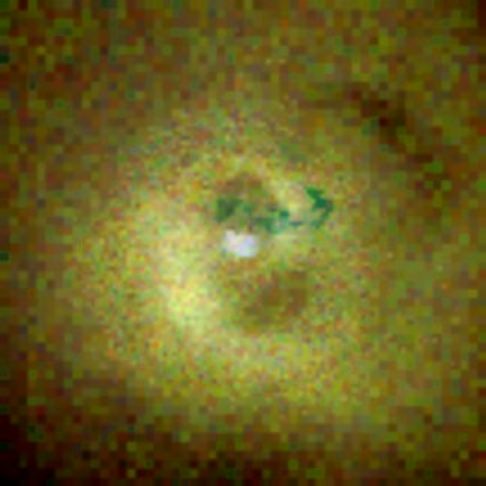
|
по текстам по ключевым словам в глоссарии по сайтам перевод по каталогу |
Credit & Copyright: A. Fabian
(IoA Cambridge) et al.,
NASA
Explanation:
The Perseus Cluster
of thousands of galaxies, 320 million
light-years distant, is
one of
the most massive objects
in
the Universe.
At its core lies the giant cannibal galaxy
Perseus A
(NGC 1275), accreting matter as
gas and galaxies fall into it.
Representing low, medium, and high energy
x-rays as red, green,
and blue colours respectively,
this Chandra X-ray Observatory image
shows remarkable details of x-ray emission from this monster galaxy and
surrounding hot (30-70 million degrees C)
cluster gas.
The bright central source is the supermassive
black
hole at the core of Perseus A itself.
Dark circular voids just above and below the galaxy center,
each about half the size of our own
Milky Way Galaxy,
are believed to be magnetic bubbles of
energetic particles
blown by the accreting black hole.
Settling
toward
Perseus A, the cluster's x-ray hot gas piles up
forming bright regions around the bubble rims.
Dramatically, the long greenish wisp just above the galaxy's centre
is likely the x-ray shadow produced by
a small galaxy falling into the burgeoning
Perseus A.
1999 2000 2001 2002 2003 2004 2005 2006 2007 2008 2009 2010 2011 2012 2013 2014 2015 2016 2017 2018 2019 2020 2021 2022 2023 2024 2025 |
Январь Февраль Март Апрель Май Июнь Июль Август Сентябрь Октябрь Ноябрь Декабрь |
NASA Web Site Statements, Warnings, and Disclaimers
NASA Official: Jay Norris. Specific rights apply.
A service of: LHEA at NASA / GSFC
& Michigan Tech. U.
|
Публикации с ключевыми словами:
активная галактика - galaxy cluster - active galaxy - Perseus A - Perseus cluster - cluster - Персей А - NGC 1275 - скопление персея - рентген - Скопление галактик
Публикации со словами: активная галактика - galaxy cluster - active galaxy - Perseus A - Perseus cluster - cluster - Персей А - NGC 1275 - скопление персея - рентген - Скопление галактик | |
См. также:
Все публикации на ту же тему >> | |
